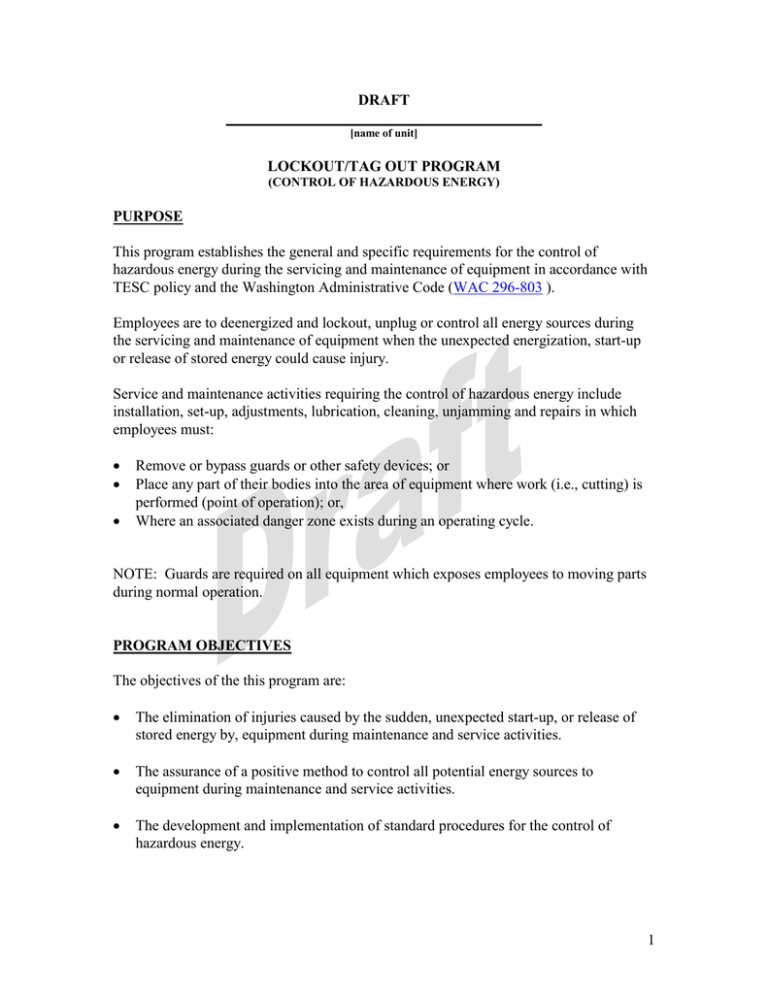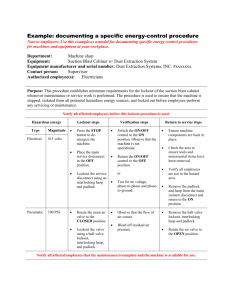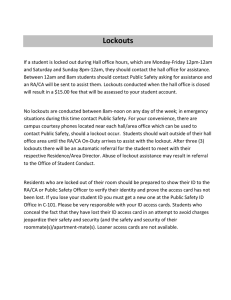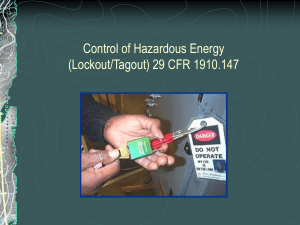Appendix K Lock-out DOC
advertisement

DRAFT [name of unit] LOCKOUT/TAG OUT PROGRAM (CONTROL OF HAZARDOUS ENERGY) PURPOSE This program establishes the general and specific requirements for the control of hazardous energy during the servicing and maintenance of equipment in accordance with TESC policy and the Washington Administrative Code (WAC 296-803 ). Employees are to deenergized and lockout, unplug or control all energy sources during the servicing and maintenance of equipment when the unexpected energization, start-up or release of stored energy could cause injury. Service and maintenance activities requiring the control of hazardous energy include installation, set-up, adjustments, lubrication, cleaning, unjamming and repairs in which employees must: Remove or bypass guards or other safety devices; or Place any part of their bodies into the area of equipment where work (i.e., cutting) is performed (point of operation); or, Where an associated danger zone exists during an operating cycle. NOTE: Guards are required on all equipment which exposes employees to moving parts during normal operation. PROGRAM OBJECTIVES The objectives of the this program are: The elimination of injuries caused by the sudden, unexpected start-up, or release of stored energy by, equipment during maintenance and service activities. The assurance of a positive method to control all potential energy sources to equipment during maintenance and service activities. The development and implementation of standard procedures for the control of hazardous energy. 1 DEFINITIONS Affected Employee: An employee whose job requires him/her to operate equipment on which servicing or maintenance is being performed under energy controlled (locked-out) conditions, or whose job requires him/her to work in an area in which such servicing or maintenance is being performed. Authorized Employee: A person who locks out equipment in order to perform service or maintenance activities. An affected employee becomes an authorized employee when that employee’s duties include performing servicing or maintenance. Crew Lockout: More than one employee affixing a lock to a single or multiple energy isolating devices. Energy Isolating Device: A mechanical device which physically prevents the transmission of energy. Examples include, but are not limited to: circuit breakers, manually operated disconnect switches, slide gates, slip blinds, line valves, blocks or similar devices with visible indication of the device’s position. Push buttons, selector switches and other controls are not energy isolating devices. Energy Source: Any electrical, mechanical, hydraulic, pneumatic, chemical, thermal or other energy, including gravity, that could cause injury to employees. Lock Box: A box which can be locked out, for use with crew lockouts or multiple point lockouts. Lockout Device: A device requiring use of lock and key to hold an energy isolating device in the deactivated position. These include, but are not limited to: electrical plug caps, valve handle chains or covers, lockout hasps, circuit breaker lockouts and ball valve lockouts. Locked-Out Condition: All energy sources to equipment are isolated and controlled through the application of locks, blinds, blocking and the dissipation of stored energy. Multiple Point Lockout: Equipment having more than one energy source and/or more than one lockout point, requiring the application of multiple lockout devices to achieve a locked-out condition. Single Point Lockout: Equipment requiring the application of a single lockout device to achieve a locked-out condition. Tag Out Device: A tag placed on a locked-out energy isolating device to identity the authorized employees and to communicate that the equipment is in a locked-out condition. 2 RESPONSIBILITY Management is to comply with and enforce all aspects of this program. Supervisors or designees have implemented the “General Lockout Procedures” in this program for equipment requiring single point lockout. Supervisors or designees have developed as necessary, equipment specific energy control procedures for equipment meeting the criteria in the “Specific Lockout Procedures” section. Supervisors are responsible for ensuring that authorized and affected employees receive training in energy control procedures. Employees are to comply with all aspects of this program. Employees are to understand that violations of lockout procedures constitute a serious safety threat to themselves and others. TESC’s Environmental Health and Safety (EHS) provides assistance in the development and implementation of, and training on, lockout procedures. ENERGY CONTROL PROCEDURES Cord and Plug Connected Equipment: Equipment powered by a cord and plug inserted into an electrical outlet receptacle are to be disconnected from the receptacle during maintenance and service activities. The plug must be under the exclusive control of the authorized person performing the maintenance or service activity. General Lockout Procedure: This procedure applies to non-cord and plug connected equipment in which a locked-out condition can be achieved with a single point lockout and there is no potential for stored or residual energy. 1. Notify all affected employees that the equipment is under maintenance or service and will be in a locked-out condition. 2. Shutdown the equipment using procedures established by the manufacturer (e.g., render equipment inoperative using control buttons, switches or handles). 3. Identify and engage the energy isolating device needed to control the energy to the equipment. The equipment will now be physically isolated from the energy source. 4. Authorized personnel apply lockout devices, locks and tags to the isolating device. Each employee working on the equipment will place his/her lock and tag on the lockout device. 3 5. Verify that the equipment is isolated from its energy source. Attempt to start the equipment using the control button, switch or handle before work is started. If the equipment does not start, return the control button, switch or handle to the “off” position to ensure the equipment does not start-up and cause injury when the equipment is re-energized. Caution: If the equipment does start-up contact the supervisor and/or EHS. A survey is to be conducted to assure all energy sources are identified. 6. After maintenance and servicing are completed the authorized employee(s) inspect the area and notify the affected employee(s) that the lockout devices are to be removed. 7. Lockout devices are removed by authorized employees. A lock may be removed only by the person who applied it. (Exception: See Special Procedures section). 8. Follow Special Lockout Procedures (outlined below) if it is necessary to temporarily activate the equipment for testing during the job or if a shift change occurs prior to completion of maintenance and service activities. Specific Lockout Procedure: Equipment specific written lockout procedures are required when equipment has one or more of the following conditions: More than one energy source; or, More than one energy isolating device is required to achieve a locked-out condition; or, There is a potential for stored or residual energy; or, The energy isolating device cannot accommodate multiple lockout devices during a crew lockout. (A lock box or similar lockout device is needed.) Equipment specific written lockout procedures are documented by completing the form at the end of this program. A copy of the form can be laminated and affixed to the equipment as a reminder and reference. Special Lockout Procedures: These procedures are to be developed as necessary to ensure employee safety during crew lockout, equipment testing, shift changes, lock removal by a person other than the one who applied it, and working with contractors. Crew Lockout: Special procedures are needed for situations when the configuration of a lockout device will not accept the weight or the number or personal locks required. These procedures will be developed and documented with assistance from EHS to assure employees are afforded a level of protection equivalent to that provided by each employee affixing their personal lock. 4 Equipment Testing: In situations when locks must be temporarily removed from lockout devices and the equipment energized to test or position equipment components, the following sequence of steps are to be followed: 1. 2. 3. 4. 5. Clear the equipment of all tools and materials. Make sure that all affected employees are clear of the machine The authorized employees remove their locks and tags and go to a safe position. Energized the equipment and proceed with testing or positioning. De-energize the equipment following the General Lockout or Specific Lockout Procedures before continuing any maintenance or service activities Shift Changes: Specific procedures addressing the orderly transfer of lockout devices will be developed for shift or personnel changes to ensure continuity of lockout protection. Contact EHS for assistance in developing transfer of lockout procedures. Lock Removal: If an employee leaves the work-site without removing his/her lock from a lockout device and the equipment must be returned to service the following procedure is to be followed: The employee’s supervisor is to verify that the authorized employee is not at the facility. All reasonable efforts are to be made to contact the employee who applied the device to inform him/her that the lock has been removed. The supervisor will assure that the authorized employee has been informed that his/her lock had been removed before the employee resumes work at the facility. The supervisor is to complete the “Notification of Lock Removal” form located at the end of this program. Working with Contractors: Whenever outside servicing personnel are working at the facility equipment, the unit supervisor and the contractor(s) will inform each other of their respective lockout programs. LOCKOUT HARDWARE AND SUPPLIES Each person authorized to routinely lockout equipment is to be issued a lock(s) and appropriate lockout devices (e.g., hasps). Locks are to meet the following criteria: Provided by the unit. Singularly keyed. Equipped with label or tag identifying the authorized employee. Used only for locking out equipment. Standardized within a unit (standardized by color, size or shape). EMPLOYEE TRAINING 5 Each authorized employee is to be trained by the supervisor or designee prior to working on equipment requiring the control of hazardous energy (lockout). The training includes: The recognition of applicable energy sources. The types and magnitude of energy in the workplace. The general, specific and special procedures to isolate and lockout hazardous energy. Each affected employee is to be trained by the supervisor or designee. The training includes: The purpose and use of the lockout procedures. The prohibition of attempting to restart or reenergize equipment which are locked-out. Retraining is to be provided for all authorized and affected employees whenever there is: A change in job assignment. An addition or modification of equipment or processes presenting a new hazard. Modification of the lockout procedures. A periodic inspection of employee performance indicates the employee’s knowledge and understanding of the lockout procedure is inadequate. Supervisors are to document employee training using the form in appendix C. Contact EHS for assistance in lockout/tag out training. PERIODIC INSPECTION A periodic inspection is to be performed by the supervisor at least annually to evaluate the program’s effectiveness. The inspection is to include observing a representative sample of each type of lockout procedure and interviewing authorized employees. The supervisor is to complete the “Lockout Procedure Inspection Record” located in the back of this program. All deficiencies identified during the inspection will be corrected. 6 The Evergreen State College Individual Equipment Lock Out/Tag Out Work Plan Equipment (System) Description: Location of Equipment (System): Hazardous Energy Type(s) Hydraulic Electrical Chemical Mechanical Gravity Thermal Pneumatic Other To Isolate – Describe Isolating Devices (type, location switch, valve, etc), Control Devices (lock, tag, chain) and Test Method 1. 2. 3. 4. 5. 6. 7. 8. To Re-energize – Describe steps to re-energize equipment 1. 2. 3. 4. 5. 6. 7. 8. 7 The Evergreen State College Group Lock Out/Tag Out Work Form Designated Employee: Date: Is responsible for all employees working under this Group Lock Out work assignment and associated work. He/she shall ensure compliance with the Group Lock Out procedures, maintaining this form and returning this form to his or her supervisor. Supervisor/Lead: Date: Equipment to be Locked Out: Location of Equipment: Employees participating in Group Lock Out Employee Name Lock Applied (date/time) Lock Removed (date/time) 8 9




